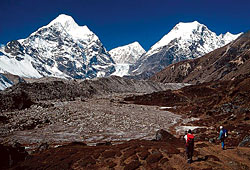 Aturf war between government departments has cost Nepal a landmark international scientific survey of one of the world's richest biodiversity areas.
Aturf war between government departments has cost Nepal a landmark international scientific survey of one of the world's richest biodiversity areas. Bureaucratic bungling, professional rivalry and an international conservation group that underestimated Nepal's red tape and displayed some highhandedness have cost science a major study of the Barun Valley in eastern Nepal.
The Makalu Barun National Park lies in a vertical world from 1,000m on the gorge of the Arun River right up to summit of Makalu at 8,484m. Because of its location, it gets the full blast of the monsoons, giving the cloud forests and the high mountain meadows of the region the richest biodiversity in the world.
That is why international environmental group, Conservation International (CI) chose to conduct its scientific study and specimen collection here this year. The group took an expedition consisting of14 Nepali and foreign scientists and three television networks from 27 October to 11 November to Saisima, a side valley of the Barun.
World-renowned biologists found three new species of ants, a number of new plants and possibly a new species of frog. Disney and Discovery crews, including Jeff Corwin, filmed the entire expedition for a special segment of the popular 'Corwin's Quest' segment about Nepal's biodiversity on Animal Planet.
CI's Rapid Assessment Team had reason to be ecstatic. But one day before the helicopters were supposed to fly in the expedition out of the Barun (12 November) the satellite phone rang. It was a message from the Department of National Parks and Wildlife Conservation (DNPWC) in Kathmandu: CI's request for specimen collection had been denied.
The scientists were shocked, and when the full implication of that news hit them, some even began to sob with frustration. Without being able to take the specimens out for further analysis there was no point.
A Nepali Times investigation has found that a turf war between the Ministry of Forest and Soil Conservation and the Department of National Park and Wildlife Conservation appears to have been at the root of the permit cancellation. But CI also did not have all the permission in writing and yet it arrogantly went ahead with its studies in the field.
The Mountain Institute (TMI) in Kathmandu coordinated the visit and had written to the Department seeking permission for specimen collection in August. The Ministry sought a four-point clarification from TMI, including a query on the authorship and intellectual property rights on the final report and filming.
"Owing to the Dasain holidays, processing of the letter took time whereas the RAP team was arriving on 27 October ," explains TMI's Himal Program Director, Brian J Peniston. The visit was an activity of CI's Rapid Assessment Program (RAP), an innovative biological inventory program designed to use scientific information to catalyse conservation action. RAP methods are designed to rapidly assess the biodiversity of highly diverse areas and to train local scientists in survey techniques.
The Ministry later issued an eight-point letter stating that the team could not take samples, that they needed to get clearance from the Home and Defence Ministries and that the Forest Ministry should get to designate the team of Nepali scientists. It was this last point, insiders say, which annoyed the officials at the Ministry because CI and TMI had already selected their own team of Nepali scientists.
DNPWC officials accuse the Ministry officials of highhandedness and say rules allow the Department to decide on expeditions of this nature. "It was interference from the Ministry that created the whole problem," said one senior DNPWC official.
Peniston told us that the secretary of the Ministry of Forest, Ananta Raj Pandey, gave verbal approval to the team to leave for the national park. But it looks like CI had nothing in writing about samples. "After that phone call, we returned all the samples to the habitat," says one of the six Nepali scientists in the team.
CI and TMI had corresponded with Nepali scientists since July seeking their participation. But even while awaiting written approval, planning for the expedition went ahead. Unused to strict red tape, the scientists may have mistakenly thought permission was just a formality because they had brought along snap traps, mist nets and other equipment to snare bats, rodents and reptiles. Their preparations also showed that they had taken things for granted.
The CI RAP team has conducted 41 expeditions to biodiversity hotspots around the world, including Peru, Bolivia, Guyana and Papua New Guinea and this is the first time it's had a problem like this.
While the CI team continued its work in the park, TMI was frantically waiting for the Forest Ministry's response on a request that sample collections be allowed. Peniston learnt it was a 'no' only one day before the team left the park. "Needless to say, they were dejected and depressed. They carried back no samples with them at all," he says.
CI and TMI say they did everything in good faith and went through proper channels to get permission. Says Leeanne Alonso of CI: "When the team received word in the field via satellite telephone that the collecting permits had not been granted, they were disappointed but this did not affect their visit since they had already been doing observations only."
In the end, it was Nepal that was the ultimate loser: we lost the publicity that would have gone with the discoveries and our scientists would have gained from future collaboration. Said one senior official at the DNPWC: "It could have been a win-win situation, it turned out to be a lose-lose one."


